28.02.2019
Works by Raphael. A romantic, mysterious and tragic love story of a great artist. Artist - a special style of thinking
Raphael (Rafaello Santi) (1483 - 1520) - artist (painter, graphic artist), architect of the High Renaissance.
Raphael Santi biography
In 1500 he moved to Perugia and entered the Perugino studio to study painting. At the same time, Raphael performed the first independent works: the skills and abilities taken over from his father affected. The most successful of his early works - "Madonna Conestabile" (1502-1503), "The Knight's Dream", "Saint George" (both 1504)
The danger of the stylistic credit characteristic of Greco-Roman pagan art has always existed, given the socio-cultural conditions in which Byzantine art flourished, but it was periodically sanctioned. The temptation to perpetuate the means of expression of pagan art did not disappear with the decrees of Theodosius the Great; they could pull out pagan temples and altars, but they could not stop the fascination with the art of those who are associated with the earthly, not the heavenly.
As a result, Canon 100 of the Queenisect Synod adopted an attitude towards the "pagan immaturity" manifested in profane art. Or, if no means of expression are allowed in the art of desecrated content, the more difficult it is to believe that Christian spirituality would be accustomed to surrounding painted images in a manner characteristic of pagan art.
Feeling like an accomplished artist, Raphael left his teacher in 1504 and moved to Florence. Here he worked hard to create the image of the Madonna, to whom he dedicated at least ten works (Madonna with the Goldfinch, 1506-1507; Entombment, 1507, etc.).
At the end of 1508, Pope Julius II invited Raphael to move to Rome, where the artist spent the final period of his short life... At the Pope's court, he received the position of "artist of the Apostolic See." The main place in his work is now occupied by the paintings of the ceremonial chambers (stanzas) of the Vatican Palace.
But it is precisely in the art of being a means of translating beauty into matter that there is a danger of confusion and confusion. Naturally, the classical Good, Truth, Beautiful is the biblical triad of Jesus Christ. That embodies the Way, Truth and Life. From this it followed that Christian art was evidence of the active presence of the One who is the Path to Beauty.
Of all the aesthetic categories, it seems that the beautiful was more difficult to integrate into christian world and develop. Like the iconoclasts, the Beautiful was and remains the most subtle and dangerous category of the famous triad. The threat to define the sacred with Truth and Goodness manifests itself often in the history of Judaism and Christianity, but it is worth noting that both the second commandment of the Decalogue and the message of the Hebrew prophets consider defining the sacred beautiful as a temptation To create an aesthetics that has come to understand the reality of this temptation, a complex theological and philosophical concept is needed.
In Rome, Raphael achieved perfection as a portrait painter and acquired the opportunity to realize his talent as an architect: from 1514 he supervised the construction of St. Peter's Cathedral.
In 1515 he was appointed commissioner for antiquities, which meant the study and protection of ancient monuments and control over excavations.
The most famous of the works of Raphael, "The Sistine Madonna" (1515-1519), was also written in Rome. AT last years life, the popular artist was so loaded with orders that he had to delegate their implementation to students, limiting himself to drawing up sketches and general control over the work.
He died on April 6, 1520 in Rome.
But the transfer of this Beauty in the painting itself hides the danger of focusing only on the beauty of compositional, chromatic, combinations of materials with varied and captivating textures. Iconographic art is in danger of disappearing behind plastic art.
This process took place over a long and almost unstable period, at a time when western mentality remained an influx of an exclusively didactic and aesthetic view of the icon and its role in christian life... From this point of view, it doesn't matter if there is an icon or a religious image in churches. Violation of the "barbaric tradition of the Greeks" forced Western religious art to break away from the icon and remain anchored only within religious painting. The human model took the place of the divine, art became an end in itself, becoming deified like an artist.
The tragedy of the brilliant master was that he could not leave behind worthy successors.
However, Raphael's work had a huge impact on the development of world painting.
The work of Raphael Santi
The idea of \u200b\u200bthe brightest and loftiest ideals of the humanism of the Renaissance was most fully embodied in his work by Raphael Santi (1483-1520). The younger contemporary of Leonardo, who lived a short, extremely busy life, Raphael synthesized the achievements of his predecessors and created his ideal of the beautiful, harmoniously developed person surrounded by stately architecture or landscape.
This religious painting, broken by the traditional canon, became dependent on the style of the era and the painterly specifics of the artist. Artistic genius, which for the most part was not lacking, became the criterion for the acceptance of a religious painting in a sacred space. Subject, often in doubtand the pictorial craftsmanship opened the wide gates of the churches to allow the painting and the statue to penetrate. That a religious subject and a genius signature are worthy of the Church's acceptance.
In a vision in which artistic value prevails, it is not surprising that the icon has become just an artistic object, like other paintings, the aesthetic value of which is beyond question, but which fall into the artistic sphere and religious, remaining outside the liturgical universe.
As a seventeen-year-old boy, he discovers real creative maturity, creating a number of images full of harmony and spiritual clarity.
Delicate lyricism and subtle spirituality distinguish one of his early works - Madonna Conestabile (1502, St. Petersburg, Hermitage), an enlightened image of a young mother depicted against the background of a transparent Umbrian landscape. The ability to freely arrange figures in space, to connect them with each other and with the environment is also manifested in the composition "The Betrothal of Mary" (1504, Milan, Brera Gallery). The spaciousness in the construction of the landscape, the harmony of forms of architecture, the balance and integrity of all parts of the composition testify to the formation of Raphael as a master of the High Renaissance.
Only important shiny handthat signed the "badge" or better said the painting, so it should be stored and maintained with care. Thus, a transition from artistic to liturgical authenticity is required. The face of the Mother of God has long disappeared behind all the women who challenged their primacy in the picture to transfer the canvas of this face.
In fact, he was working with an ideal created by a "divine artist." And therefore, it is automatically assumed that what was divine from an artistic point of view could only be divine and iconographic. Holiness certification is directly related to artistic value.
With his arrival in Florence, Raphael easily absorbs the most important achievements of the artists of the Florentine school with its pronounced plastic beginning and wide coverage of reality.
The content of his art remains a light lyrical theme maternal love, to which he attaches particular importance. She gets a more mature expression in such works as "Madonna in the Green" (1505, Vienna, Kunsthistorisches Museum), "Madonna with the Goldfinch" (Florence, Uffizi), "The Beautiful Gardener" (1507, Paris, Louvre). In essence, they all vary the same type of composition, composed of the figures of Mary, the infant Christ and the Baptist, forming pyramidal groups against the background of a beautiful rural landscape in the spirit of compositional techniques found earlier by Leonardo. Naturalness of movements, soft plastic forms, smoothness of melodious lines, beauty ideal type Madonnas, the clarity and purity of landscape backgrounds help to reveal the sublime poetry of the figurative structure of these compositions.
For example, Madona Sistina Raphael said: "As long as the painting of the century can represent the history of the world, Madonna will remain one of the noble concepts of human poetry: a worthy painting of the Virgin Mary." The fact is that the manifestation of admiration, which was felt in front of a work of art with a religious theme, is even considered a kind of "barometer" of genuine Christian life. We must not forget that for Orthodox spirituality, artistic emotions do not automatically imply a spiritual earthquake, as long as the world that is present before our eyes, also this world - transposed in accordance with the stylistic principles of the weather, in any case, as natural as possible - and not a transformed world, characteristic for the icon.
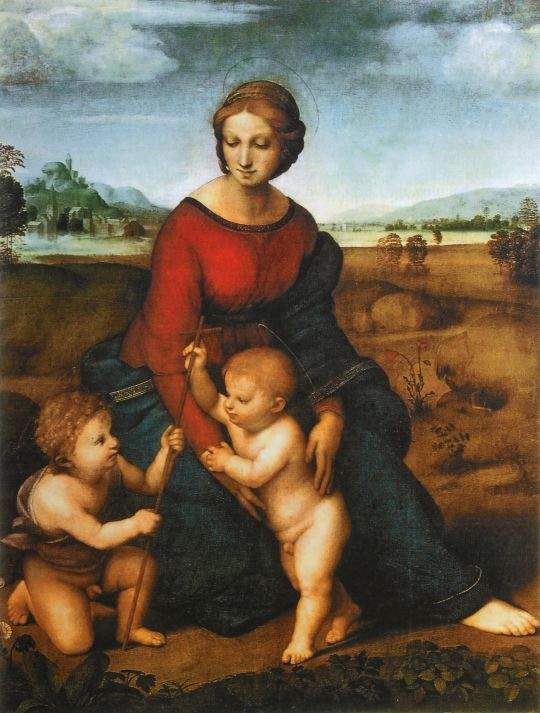
In 1508, Raphael was invited to work in Rome, to the court of Pope Julius II, a domineering, ambitious and energetic man who sought to increase the artistic treasures of his capital and attract the most talented cultural figures of that time to his service. At the beginning of the 16th century, Rome inspired hopes for the national unification of the country. The ideals of the national order created the basis for creative growth, for the embodiment of advanced aspirations in art. Here, in close proximity to the heritage of antiquity, Raphael's talent flourishes and matures, acquiring a new scope and features of calm grandeur.
But in this joy of deliverance from the canons, in this solution to what was created in the image of God, and now, seeing his face everywhere, he forgot that art is essentially metaphysical and sacred. This perspective is canceled in Europe at the end of the Middle Ages: it is completely lost sight of the sacred content of beautiful works. The loss of reason, an art, is itself an art of beauty, while in traditional cultures the beautiful was hidden and absorbed in its very function. concept visual artsand also the concept of "artist".
Raphael receives an order to paint the ceremonial rooms (the so-called stanzas) of the Vatican Palace. This work, which continued intermittently from 1509 to 1517, nominated Raphael among the greatest masters of Italian monumental art, confidently solving the problem of the synthesis of architecture and painting of the Renaissance.
The gift of Raphael, a monumentalist and decorator, manifested itself in all its brilliance during the painting of the Station della Senyatura (printing room).
On the other hand, reduced to action, that is, to activity based on information about nature, art is increasingly perceived as free and artificial. Art becomes for itself by itself, turns into an end in itself, begins to become "art for art."
Nowadays they talk about "dehumanizing art". But along with the process of disintegration or absence of identity, its reassessment also occurs. It becomes a surrogate even for religion, as we have seen, but for all other considerations. There was a time when it was believed that only science and technology can provide the answer to the sense of life that a person is constantly looking for, since they can only offer facts, being incapable of anything else. We don't need to decide if this is the case. we must live, people no longer look exclusively at religion, but, as we see, more and more in art and artists.
On the long walls of this room, covered with sailing vaults, there are compositions "Dispute" and "School of Athens", on the narrow walls - "Parnassus" and "Wisdom, Moderation and Strength", personifying the four areas of human spiritual activity: theology, philosophy, poetry and jurisprudence ... The vault, divided into four parts, is decorated with allegorical figures that form a single decorative system with wall paintings. Thus, the entire space of the room was filled with painting.
Those who no longer believe in Christ are inclined to the resurrection Piero della Francesca, devoid of religious reality, the picture remains a fictional creation, but the fictitious creation is not a simulacrum, and today the aesthetic value has acquired the power of a privileged reality, which, of course, is the event of our capital. time, an event that we are just beginning to realize. Indeed, art, but also artists, after long journey managed to take a leading position on the cultural scene of humanity.
They moved from their exclusion from Plato's ideal state to divination in a structured anthropocentric society. Artistic perception was found to exclude any reference to original theme or a goal, having as its only center of interest art, but especially its demiurge, the artist.
Dispute School of Athens Adam and Eve
The unification of the images of the Christian religion and pagan mythology in the murals testified to the spread among the humanists of that time of the ideas of reconciling the Christian religion with ancient culture and of the unconditional victory of the secular principle over the church. Even in the "Dispute" (the dispute of the church fathers about the sacrament), dedicated to the depiction of church figures, among the participants in the dispute, one can recognize poets and artists of Italy - Dante, Fra Beato Angelico and other painters and writers. The triumph of humanistic ideas in Renaissance art, its connection with antiquity, speaks of the composition "School of Athens", glorifying the mind of the beautiful and strong man, ancient science and philosophy.
In such an assessment of the centers of interest, it is not surprising that, as Andreas Frossard noted, Raphael Deva is called "Raphael". The artistic genius leaves the genius of holiness in the shadow. to some extent it was confiscated in order to become a good companion for the one who created it, that is, the artist, and with the consent of those who had to make sure that this did not happen, that is, from the elders of the Catholic Church.
If an example of a divine image is considered, which is the crucifixion, it was a kind of canon. These images depend on the artist's personal meditation, the aesthetic and religious synthesis he makes about this. The intervention of valuable artists in the Western chapels has turned them into veritable museums or altars dedicated to art and artists. in these spaces there is nothing to recognize, except for the fact that "this is Matisse!", "this is Cocteau!" - so there is something to see, but not to pray - to be seen; we forget that they are "Matisse" or "Cocteau" - we must forget about the visible.
The painting is perceived as a dream come true for a bright future.
From the depths of the suite of grandiose arched spans, a group of ancient thinkers emerges, in the center of which is the stately gray-bearded Plato and the confident, inspired Aristotle, with a gesture of his hand pointing to the ground, the founders of idealistic and materialist philosophy. Below, to the left of the stairs, Pythagoras bent over the book, surrounded by his students, to the right - Euclid, and here, at the very edge, Raphael depicted himself next to the painter Sodoma. This is a young man with a gentle, attractive face... All the characters in the fresco are united by the mood of high spiritual uplift and deep thought. They make up groups, indissoluble in their integrity and harmony, where each character precisely takes its place and where architecture itself, in its strict measure and majesty, contributes to the recreation of an atmosphere of high rise of creative thought.
These chapels celebrate their authors, not the recipient - they have the function of simple idols, not icons. Even in orthodox world things are not better. How many artists or art lovers do not exclaim: "Rubles" instead of "Holy Trinity", or do not think that "it is worth visiting the page with Theo-fan, to see his Christ!" - "Which one, Theophanes, Greek or Crete?"
Or, as many of us do not think, the atmosphere of the church is more “godly” than the other, because the picture carries a famous signature. Under no circumstances was the transformation brought about by the beauty of Christian painting diminished in any way, but the danger of putting the creator in the face of the Creator could not be ignored. How many of those who contemplate the famous orthodox icons, do not allow themselves to steal their aesthetic admiration, forgetting the dialogue with the saint, whose face they have in front of them?
The fresco "The Expulsion of Eliodor" in Stanza d'Eliodoro stands out for its intense drama. The suddenness of the happening miracle - the expulsion of the robber of the temple by the heavenly horseman - is conveyed by the swift diagonal of the main movement, using the light effect. Pope Julius II is depicted among spectators gazing at the exile of Eliodorus. This is an allusion to events contemporary to Raphael - the expulsion of French troops from the Papal States.
Man will replace himself with the divine, taking advantage of man's specific ability to be a creator of art. He no longer worships the icon, but art no longer remembers the saint, but the one who gave him life in painting. The danger is not manifested only in the type of Western Christianity that is accustomed to honor human faces the names of the saints.
In this sense, we can say that Russian icon painting tended to decorative patternthat abstracts art, not message. He cannot overcome the temptation of a theoretical model, formal "manners". In front of the Russian icon, you often do not find evidence of an existential transformation of nature, but the idea of \u200b\u200btransformation, the date of a formal, decorative style. and, as a rule, give the impression of spiritualization and dematerialization: the folds of the clothes are not the real body under the clothes, the attitude of the body and their movements are not natural, but the geometrically schematic lights do not scatter almost the same color, to create the impression again, from a bright light manner, it is difficult describe these real differences in words, and yet they are necessary when comparing Greek and Russian icons.
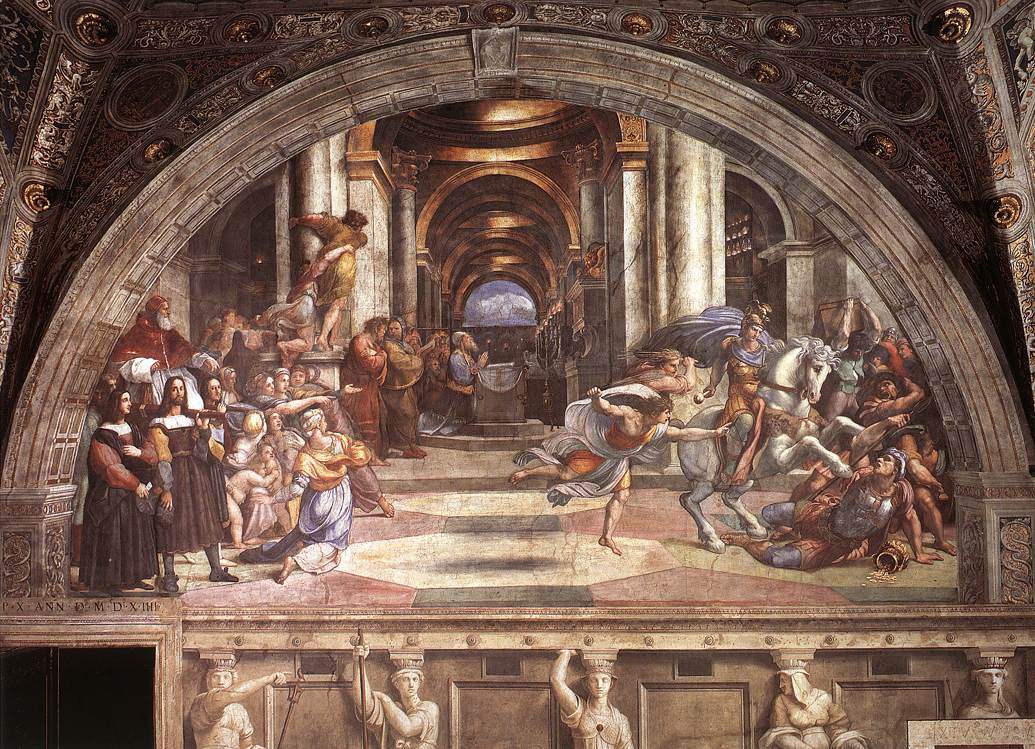
Raphael's Roman period was marked by high achievements in the field of portraiture.
Sharp portrait features acquire full of life characters from Mass in Bolsen (frescoes in Stanza d'Eliodoro). Raphael also turned to the portrait genre in easel painting, showing his originality here, revealing the most characteristic and significant in the model. He painted portraits of Pope Julius II (1511, Florence, Uffizi), Pope Leo X with Cardinal Ludovico dei Rossi and Giulio dei Medici (about 1518, ibid.) And other portrait paintings. An important place in his art continues to be occupied by the image of the Madonna, acquiring the features of great grandeur, monumentality, confidence, and strength. This is the Madonna della Cedia (Madonna in the Chair, 1516, Florence, Pitti Gallery) with its harmonious, closed composition.
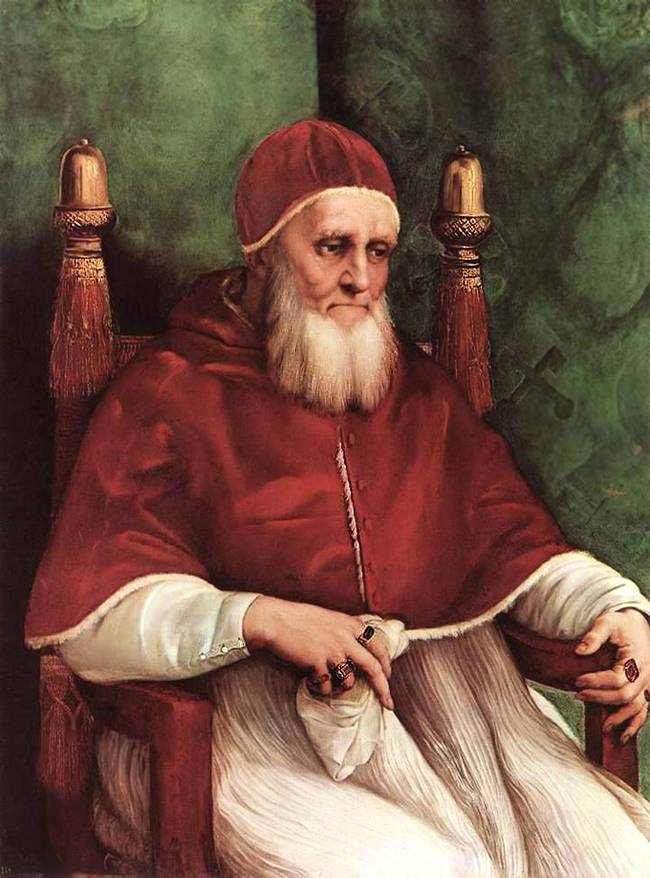
At the same time, Raphael created his greatest creation "Sistine Madonna" (1515-1519, Dresden, Picture Gallery), intended for the church of St. Sixtus in Piacenza. Unlike the earlier, lighter in mood, lyrical Madonnas, this is a stately image full of deep meaning. The curtains spread from the top on the sides reveal Mary easily walking on the clouds with a baby in her arms. Her gaze allows you to look into the world of her experiences. Seriously and sadly, she looks somewhere into the distance, as if anticipating tragic fate son. To the left of the Madonna is Pope Sixtus, enthusiastically contemplating a miracle, to the right is Saint Barbara, who reverently lowered her gaze. Below are two angels looking up and, as it were, returning us to the main image - the Madonna and her childishly pensive baby.
Flawless harmony and dynamic balance of the composition, delicate rhythm of smooth linear outlines, naturalness and freedom of movement make up the irresistible power of this whole, beautiful image.
The truth of life and the features of the ideal are combined with the spiritual purity of the complex tragic nature of the Sistine Madonna. Some researchers found its prototype in the features of "Ladies in a Veil" (about 1513, Florence, Pitti Gallery), but Raphael himself wrote in a letter to his friend Castiglione that his creative method is based on the principle of selection and generalization of life observations: to write a beauty, I need to see many beauties, but due to the lack of ... beautiful women I use some idea that comes to my mind. " Thus, in reality, the artist finds features that correspond to his ideal, which rises above the accidental and transitory.
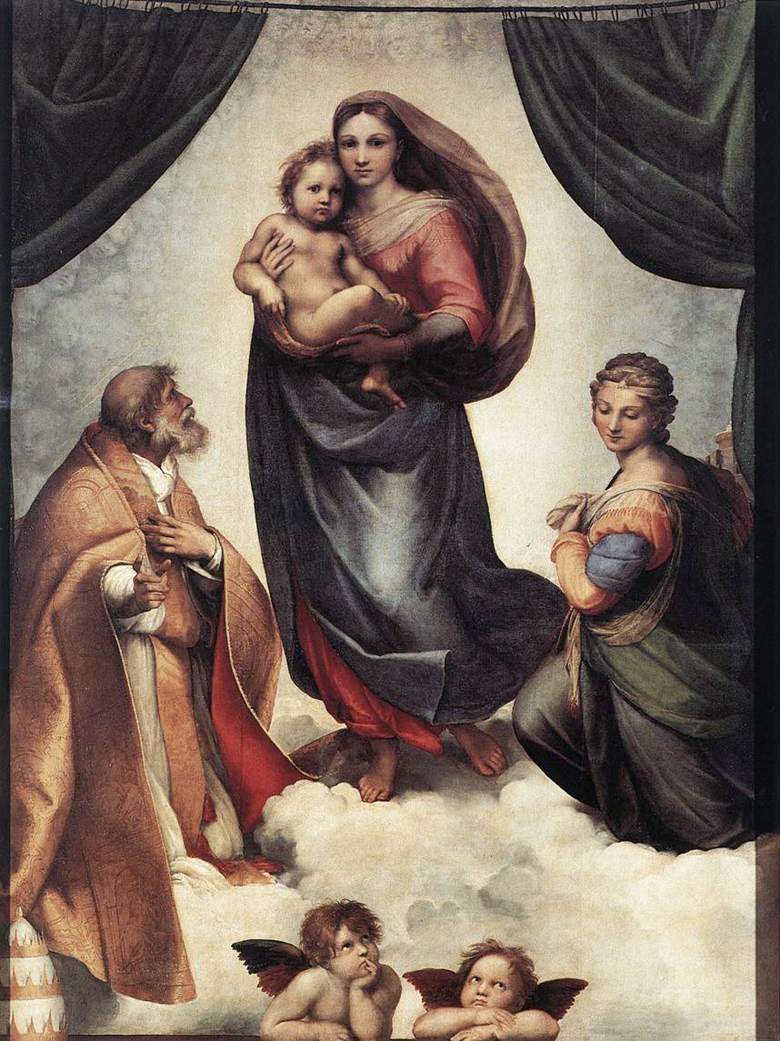
Raphael died thirty-seven years old, leaving unfinished paintings of the Villa Farnezina, Vatican Loggias and a number of other works, completed on cardboard and drawings by his students. Free, graceful, casual drawings by Raphael put their creator into the ranks of the largest draftsmen in the world. His work in architecture and applied arts testify to him as a versatile gifted figure of the High Renaissance, who won great fame among his contemporaries. The very name of Raphael later became the common name of the ideal artist.
In the view of the people of the Renaissance, beauty is primarily an ordered consonance and combination of parts, harmony. It is based on proportion, a perfect image, where, in the words of the Italian scientist and architect Alberti, "nothing can be added, nor subtracted, nor changed without making it worse."Numerous Italian students and followers of Raphael elevated the teacher's creative method into an indisputable dogma, which contributed to the spread of imitation in Italian art and foreshadowed the imminent crisis of humanism.
In the resurrected Renaissance, the ancient formula “beauty is harmony” expressed both the essence of art and a peculiar idea of \u200b\u200bthe world around us. According to the people of that time, all living things are harmonious. Beauty in art is a reflection of beauty in nature. This understanding of it gave the Renaissance ideals naturalness, full-bloodedness and incomparable charm.
Raphael's art and life itself can serve as an example of Renaissance clarity, love for life, poise, noble simplicity. Many artists strove to embody these ideals in their work. But he was that happy master, in whose works they received a complete and perfect reflection.

In his life there were no conflicts, dissatisfaction with himself, the eternal contradiction between the desired and the achieved. Raphael, thanks to the happy traits of character, always set himself feasible tasks and performed them so easily, as if it was not worth any effort. He always studied with his contemporaries, unmistakably finding and organically assimilating what he lacked. Intuitively he avoided difficulties that became almost insurmountable for artists who perceived the world more difficult and more dramatically.
Rafael Santi was born on April 6, 1483 in Urbino, a small town in the Italian region of Marche. His father Giovanni Santi, a painter and poet, gave the first painting lessons, which were continued with local artists. At the age of 17, he entered the workshop of Perugino.

Raphael's early painting is almost no different from the lyrical works of teachers: light figures are painted against the background of landscapes, they are located simply and directly. Even then, at the age of 20, in "Madonna Conestabil" he creates his own ideal world, demonstrating compositional skill. Raphael's ability to organize the image, to connect the figures with each other and with the background is truly amazing. He is an unsurpassed master of composition, which is a guiding thread in the perception of any of his work.
1504-1508 Raphael spends in Florence. He works on the images of the Madonna, demonstrating inexhaustible imagination in search of new solutions to the traditional plot. And of course, he continues to study - he adds to the grace that distinguished his youthful works, purely Florentine plastics, monumentality. Seeks to master Leonardo da Vinci's smoky chiaroscuro. One of the paintings from this period - "The Holy Family" can be seen in the Hermitage.
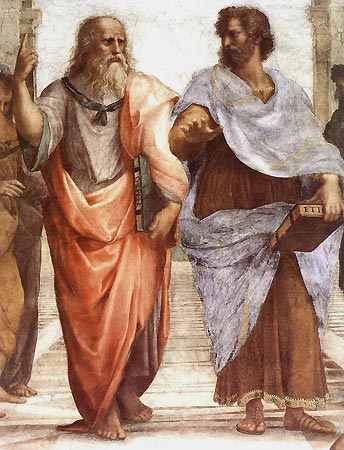
In 1508 he moved to Rome. The grandeur of the orders entrusted, the very spirit of the ancient city, raise Raphael to a higher level of skill. He finds himself in an environment where majestic luxury was combined with the ideas of humanism, ostentatious splendor with the requirements of measure and artistic taste. In the work on the painting of the rooms ("stanzas") of the Vatican Palace, a characteristic feature of Raphael's art was manifested - the synthetic nature of images, the ability to organically generalize natural observations.
Let's compare the most famous fresco of this mural - "School of Athens" with a preparatory sketch. You can see how the figures are transformed, unnecessary details disappear, how the image loses everything momentary, everyday and becomes monumental. The peculiarity of Raphael is not that he created these idealized images, but that in them the real is always felt, taken from nature. He subtly feels the line between the real and the ideal, does not break away from life, does not turn to the fictional, which so often happened to his followers. In the works of Raphael, the direct sense of the colorist is adjacent to the rationally verified drawing, perfect proportions, and this is a sign of truly classical art.
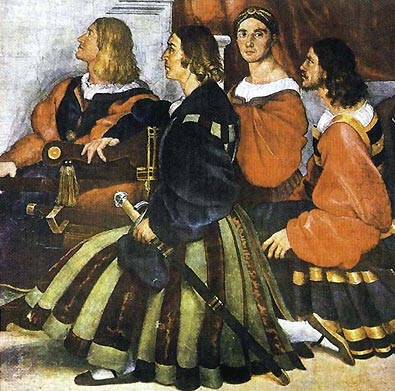
In the paintings of the stanzas, Raphael displayed an exceptional gift as a monumentalist. An unforgettable example is the figures of Plato and Aristotle in the fresco "School of Athens". This talent is not only in the severity and purity of the drawing, in the ability to highlight the main thing, but also in the ability to combine numerous images in a single complex ensemble. Raphael acts here both as a painter and as an architect and composer. Hence - the clarity of construction and the noble beauty of lines and contours, melodic in their structure.
Creating a heroic world in frescoes, Raphael remains true to reality. The frescoes were preceded by numerous drawings, sketches, and life sketches of groups of figures and persons. Each character is individual, almost all images are portrait. We see popes and their entourage, cardinals, guards: many are easily recognizable. Right part The frescoes "Mass in Bolsen" are essentially a large group portrait, in which the truth of life and generalization are fused together.
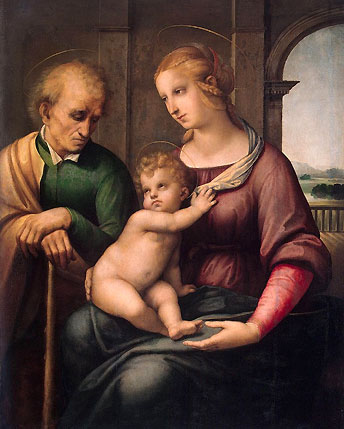
The portraits in the frescoes are very close to the easel works in their external simplicity, the elevation of the image. As in monumental works, the artist somewhat idealizes the model, seeks to see the typical, to create an image perfect man Renaissance. Humanistic ideas about the high purpose of a person, virtues and reason become in Raphael one of the means of portrait characterization. People in the picture are always calm, self-confident, full of dignity. Them peace of mind unwavering.
Let's take a look at the austere portraits of the cardinal and B. Castiglione. In them you discover more and more new virtues - the richness of spiritual content is guessed behind the outward simplicity. Raphael had the gift of seeing proportionality, harmony in everything: in the world around him, in nature, in people. And not only to see, but it is easy, joyful to embody it.

In 1513-1514, temporarily leaving work on numerous orders, Raphael created one of the best works for the monastery church of St. Sixtus in the town of Piacenza - "The Sistine Madonna". This was the result of his work on the image of the Mother of God - a masterpiece in which the master most fully expressed his ideal. It is believed that the painting was commissioned by Pope Julius II, who considered Saint Sixtus to be his patron. It served as a funeral image, which traditionally represents the Mother of God, as if appearing to the deceased. But, as noted by the outstanding art historian MV Alpatov, "in Raphael's painting, the appearance of the Madonna to the deceased Pope Julius turned into a phenomenon to her people, which was told about in ancient legends."
Her image is human and beautiful. Barefoot, she descends from the sky towards people with her son in her arms. Sixtus, who has taken off the papal tiara, and Saint Barbara, expressing humility and reverence, greeted her as a queen. The formula of classical art - "noble simplicity and calm grandeur" - is fully applicable to the creation of Raphael.
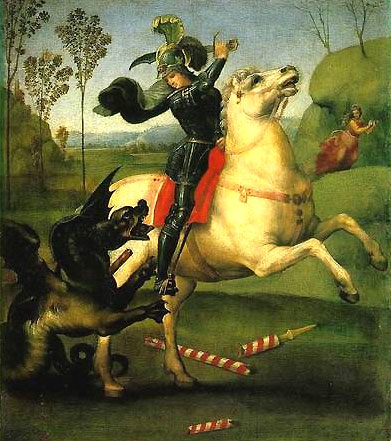
Raphael. "Saint George defeating the dragon." Butter. 1505.
In the last five years of his life, he has been engaged in architecture, is passionate about the study of ancient buildings in Rome. Supervises the implementation of numerous orders that his students are working on, which could not but affect the quality of the works. But it was then that Raphael fully reveals the talent of a decorator in the paintings of the so-called "Loggia of Psyche" at the Villa Farnesina and the loggias of one of the courtyards of the Vatican. They were completed by the students, but the general idea undoubtedly belongs to Raphael. It is especially original in the frescoes of the Loggia of Psyche. The painting is presented in the form of an open gazebo with two carpets suspended at the top, as if intended to protect from the sun. But Raphael's assistants could not carry out the plan with sufficient perfection.
The share of the artist's personal participation in the preparation of carpets for carpets that adorned the famous Sistine Chapel on holidays was greater. They were considered by Raphael, like the frescoes of the Vatican stations, as a plot cycle associated with the content of the frescoes on the vault and the walls of the chapel. In the later work of the master, external beauty appears, the artistic method is simplified. Carpet boards like Miraculous Catch bring us back to his finest work with their craftsmanship. They allow us to say that the master has far from exhausted the possibilities. He died on April 6, 1520, the leading painter of Rome.
![]()
The light art of the brilliant urbanist has been attracting viewers with classical beauty for five centuries already, being, in the words of the Soviet artist P. Korin, “the ideal of pure art”. It sometimes causes disputes that arise around far from best works artist or works of students and followers. But, freed from later layers, his brilliant art appears before us as a rare synthesis of the achievements of the Renaissance. It is not without reason that the outstanding master of baroque L. Bernini always considered Raphael the first among the greats and likened him to "the big sea, which absorbed the water of all rivers."


